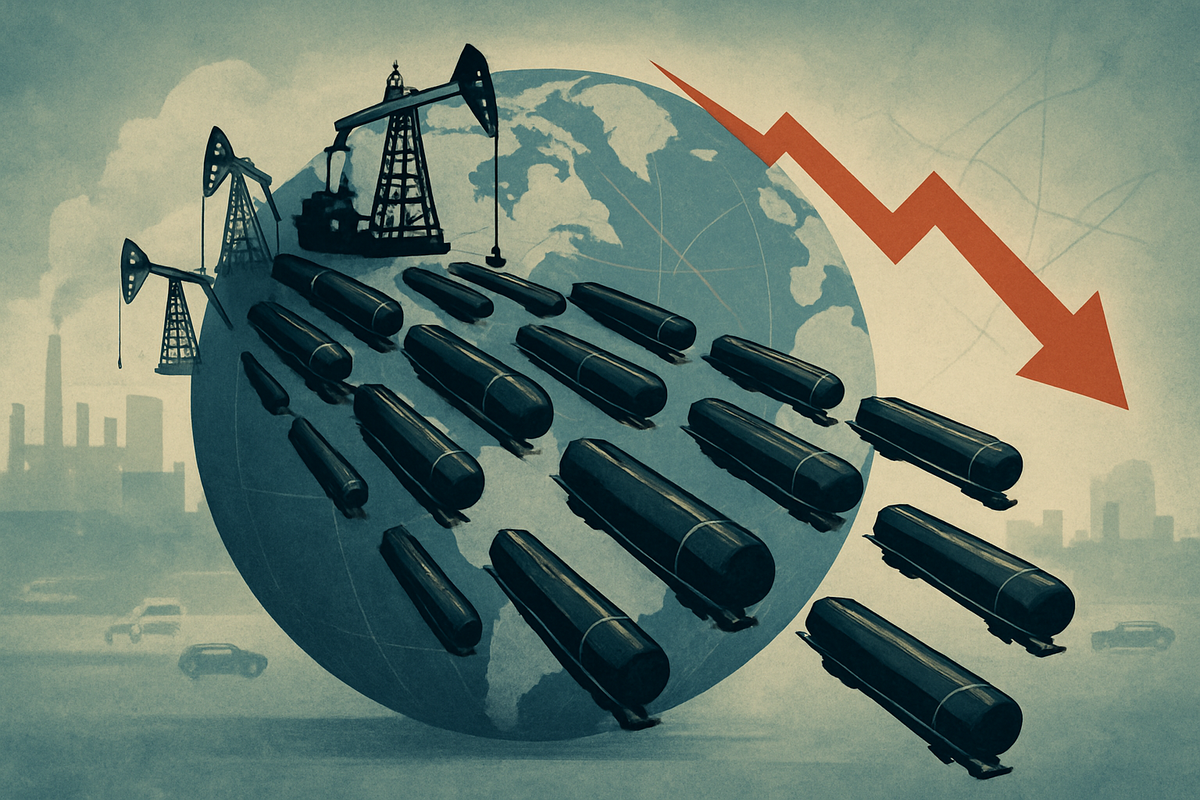
The global crude oil market in October 2025 finds itself at a critical juncture, with a confluence of surging supply, moderating demand, and persistent geopolitical tensions creating a distinctly bearish price environment. Both Brent and West Texas Intermediate (WTI) crude benchmarks have recently touched four-month lows, signaling a significant shift from previous periods of tight supply and elevated prices. This evolving landscape has immediate implications for global economies, energy producers, and consumers alike, promising a period of rebalancing as a supply-led surplus takes hold.
This dynamic interplay is poised to shape investment strategies, corporate profitability, and consumer spending in the coming months, marking a pivotal moment for an industry accustomed to volatility. The current trajectory suggests that the era of consistently high oil prices may be giving way to a more subdued market, driven by fundamental shifts in production capabilities and global economic realities.
A Deluge of Supply Meets Softening Demand Amidst Geopolitical Volatility
The current state of the crude oil market is a complex tapestry woven from robust production increases, a global economic slowdown, and an ever-present undercurrent of geopolitical risk. October 2025 has seen both Brent crude trading around $64-$65 per barrel and WTI near $60-$61 per barrel, reflecting a notable decline and a bearish sentiment projected to persist into 2026.
A significant driver of this price depression is the robust growth in global oil supply, primarily from non-OPEC+ nations. The "American quintet" – the United States, Brazil, Canada, Guyana, and Argentina – are leading this charge, with the United States setting a new record in July 2025, surpassing 13.6 million barrels per day (bpd) in crude oil production. This output is expected to be maintained through 2026, contributing substantially to a projected global supply increase of 3 mb/d in 2025 and an additional 2.4 mb/d in 2026. While OPEC+ has cautiously agreed to a modest production increase of 137,000 bpd starting November 2025, following a 1 mb/d surge in September, their efforts to manage market stability are being challenged by the sheer volume of non-OPEC+ output. This burgeoning supply has led to global observed crude oil inventories reaching a four-year high in August 2025, with a "massive buildup of oil in floating storage or in transit," the largest increase since the COVID-19 pandemic.
Concurrently, global demand for crude oil remains subdued, influenced by a "harsher macro climate" and the accelerating pace of the energy transition. Forecasts from the International Energy Agency (IEA) and the World Bank indicate a slowdown in global economic growth, particularly in major oil-consuming regions like the US and China. This deceleration is translating into lower oil consumption growth, projected at a modest 700,000 bpd in both 2025 and 2026, significantly below historical averages. Furthermore, the increasing efficiency of vehicles and the rapid adoption of electric vehicles (EVs) are acting as strong structural headwinds for road transport fuel demand. Even traditional seasonal demand spikes for heating oil in Q4 are being muted by natural gas substitution and warmer weather forecasts.
Geopolitical factors continue to inject volatility, though their immediate impact on prices is being somewhat cushioned by the prevailing supply surplus. The ongoing Russia-Ukraine conflict, including escalating attacks on Russian infrastructure, remains a critical risk. In October 2025, the US imposed comprehensive sanctions on Russia's largest oil producers, Rosneft (MCX: ROSN) and Lukoil (MCX: LKOH), aiming to increase the cost of Russia's trade. While these sanctions could theoretically tighten global supply, the current surplus capacity is expected to limit significant upward price pressure. Persistent tensions in the Middle East also maintain a risk premium, though discussions of potential ceasefires could, paradoxically, increase demand due to enhanced economic confidence. Meanwhile, a recent meeting between US and Chinese presidents in October 2025, leading to a reduction in trade barriers, offers a glimmer of hope for bolstered global economic growth and, by extension, oil demand.
Navigating the Tides: Winners and Losers in a Softening Oil Market
The current bearish outlook in the crude oil market presents a mixed bag for public companies, creating distinct winners and losers across various sectors. The shift towards lower prices, driven by an expanding supply surplus and moderating demand, will necessitate strategic adjustments and could reshape competitive landscapes.
Potential Losers:
Oil and gas exploration and production (E&P) companies, particularly those with higher operating costs or significant exposure to unconventional plays like shale, are likely to face headwinds. Companies such as ExxonMobil (NYSE: XOM) and Chevron (NYSE: CVX), while diversified, will see their upstream profitability challenged by lower per-barrel realizations. Smaller, independent E&P firms, which often operate on tighter margins, are particularly vulnerable. Reduced crude prices dampen the incentive for new production investment, leading to potential curtailments or delays in new projects. US shale producers, for instance, face increasing sensitivity to price volatility as drilling rig counts and drilled-but-uncompleted (DUC) well inventories decline in key basins. Service companies that support drilling and exploration, like Schlumberger (NYSE: SLB) or Halliburton (NYSE: HAL), may also experience reduced demand for their services as E&P budgets tighten. National oil companies (NOCs) like Saudi Aramco (TADAWUL: 2222) will see their revenues and, consequently, government budgets impacted, potentially affecting sovereign spending and investment plans.
Potential Winners:
Conversely, sectors that are major consumers of crude oil stand to benefit significantly from lower prices. Airlines, such as Delta Air Lines (NYSE: DAL) and Southwest Airlines (NYSE: LUV), will see their fuel costs—a substantial portion of their operating expenses—decrease, potentially boosting profitability and allowing for more competitive pricing. Similarly, shipping companies like Maersk (CPH: MAERSK-B) and logistics firms will experience reduced bunker fuel costs. The petrochemical industry, which uses crude oil and its derivatives as feedstocks, could also see improved margins. Companies involved in manufacturing plastics, fertilizers, and other chemical products, such as Dow Chemical (NYSE: DOW) or BASF (FWB: BAS), might benefit from lower input costs. Consumers, of course, are among the biggest winners, as lower crude prices translate directly into cheaper gasoline and heating oil. This provides relief to household budgets, potentially stimulating broader economic activity through increased discretionary spending and easing inflationary pressures. Companies in the retail and consumer discretionary sectors could indirectly benefit from this boost in consumer purchasing power.
Broader Implications: A Shifting Energy Paradigm and Economic Realignments
The current dynamics in the crude oil market extend far beyond immediate price fluctuations, signaling broader industry trends, potential ripple effects across economies, and significant policy implications. This period of oversupply and moderating demand is not merely a cyclical downturn but hints at a more fundamental rebalancing within the global energy landscape.
One of the most significant broader trends is the accelerated pace of the energy transition. While lower oil prices might temporarily reduce the urgency for some to switch to alternatives, the underlying momentum towards decarbonization, driven by climate policies and technological advancements, remains strong. The rapid adoption of electric vehicles (EVs) and increasing vehicle efficiencies are structural headwinds for long-term oil demand, indicating that the peak oil demand for road transport could be closer than previously anticipated. This trend forces oil companies to increasingly diversify their portfolios into renewable energy and sustainable solutions, or risk becoming stranded assets in the long run. The resilience of non-OPEC+ production, particularly US shale, despite previous price shocks, demonstrates a mature and efficient industry that can bring significant supply to market relatively quickly, fundamentally altering OPEC+'s traditional role as the sole swing producer.
The ripple effects on competitors and partners are substantial. For energy-exporting nations, sustained lower oil prices will strain national budgets, potentially leading to reduced public spending, deferred infrastructure projects, and increased pressure for economic diversification. Conversely, energy-importing nations, particularly those heavily reliant on oil for their industrial and transportation sectors, will experience a welcome economic boost. This could lead to a rebalancing of global trade flows and currency valuations. The competitive landscape among oil producers will intensify, with lower-cost producers gaining an advantage, while higher-cost operations may become uneconomical, leading to consolidation or divestitures.
Regulatory and policy implications are also profound. Governments in major consuming nations may see an opportunity to reduce energy subsidies, or conversely, to impose carbon taxes, as the burden of higher prices on consumers is lessened. The US sanctions on Russia's oil producers, Rosneft and Lukoil, highlight how geopolitical tools can be used to influence energy markets, even if their impact on prices is currently mitigated by surplus supply. Strategic petroleum reserves, which have been drawn down in recent years, may be replenished during this period of lower prices, offering governments a chance to bolster energy security. Historically, periods of sustained low oil prices have often been followed by economic growth spurts in consuming nations, as well as significant industry consolidation among producers. The mid-1980s and the 2014-2016 downturns serve as precedents where oversupply led to a reshaping of the energy sector, and the current environment shares many similarities, albeit with the added dimension of a global energy transition.
What Comes Next: Navigating a Period of Market Rebalancing
The crude oil market is entering a phase of fundamental rebalancing, characterized by an anticipated supply-led surplus that is expected to persist into the near to medium term. The coming months and years will be defined by how producers, consumers, and governments adapt to this new reality, presenting both challenges and opportunities.
In the short-term, the market is likely to remain under downward pressure. The US Energy Information Administration (EIA) forecasts Brent crude to average $62 per barrel in Q4 2025 and potentially fall to $52 per barrel in 2026, with WTI following a similar trajectory. This bearish outlook suggests that consumers will continue to benefit from lower fuel costs, providing a tailwind for global economic activity. However, for oil producers, the challenge will be to manage production costs and optimize portfolios to remain profitable in a lower-price environment. Smaller, independent E&P firms may face increased pressure for consolidation or even bankruptcy, while larger, more financially robust companies might strategically acquire distressed assets.
Long-term possibilities include a sustained period of lower oil prices, which could ironically slow down some investments in renewable energy if the economic incentive for switching diminishes. However, the overarching push for decarbonization and energy security is likely to maintain momentum for the energy transition. Potential strategic pivots for oil companies will involve accelerating diversification into renewables, carbon capture technologies, and other low-carbon solutions. Companies like Shell (LSE: SHEL) and BP (LSE: BP) have already embarked on such transitions, and this market environment might necessitate even faster shifts. Furthermore, governments might use this period of lower prices to implement more aggressive carbon pricing or fuel efficiency standards without unduly burdening consumers.
Market opportunities could emerge for investors in sectors benefiting from lower energy costs, such as airlines, logistics, and petrochemicals. Conversely, challenges will persist for pure-play oil and gas producers, requiring careful scrutiny of their balance sheets and operational efficiencies. Potential scenarios include a further slowdown in global economic growth, which would exacerbate the demand weakness, pushing prices even lower. Conversely, an unexpected geopolitical escalation, particularly in the Middle East or involving major oil producers, could swiftly tighten supply and reverse the price trend, albeit likely temporarily given the current surplus capacity. Another scenario involves OPEC+ taking more aggressive measures to cut production, but their ability to significantly impact prices is increasingly constrained by the robust non-OPEC+ supply.
A New Equilibrium: Preparing for a Transformed Oil Market
The current state of the crude oil market signifies a profound shift, moving towards a new equilibrium defined by abundant supply and moderating demand, all against a backdrop of complex geopolitical maneuvers. The key takeaway from this period is the undeniable rebalancing of market power, with non-OPEC+ producers, particularly the US, playing an increasingly dominant role in shaping global supply. This has effectively capped the ability of traditional cartels to unilaterally dictate prices, ushering in an era of heightened competition and price sensitivity.
Looking ahead, the market is moving towards a supply-led surplus that is projected to persist well into the medium term. This structural change implies that the volatility previously associated with supply shortages might be replaced by volatility stemming from demand fluctuations and the ongoing energy transition. For investors, this means a careful assessment of company resilience and strategic positioning is paramount. Companies with diversified energy portfolios, strong balance sheets, and a clear roadmap for navigating the energy transition are likely to be better positioned for sustained success.
Final thoughts on the significance and lasting impact suggest that this period could accelerate the shift away from fossil fuel dependency in some regions, while also providing a cost-effective energy source for others, albeit with geopolitical caveats. The easing of inflationary pressures due to lower commodity prices is a significant benefit for global economies, potentially providing central banks with more flexibility. What investors should watch for in coming months includes OPEC+'s future production decisions, which will be crucial in determining their strategy in a surplus market. Additionally, monitoring global economic growth indicators, particularly from the US and China, will be key to understanding demand trajectories. Finally, any escalation or de-escalation of geopolitical conflicts, especially those impacting major oil-producing regions or shipping lanes, will continue to be a critical factor influencing short-term price movements and market sentiment.
This content is intended for informational purposes only and is not financial advice






